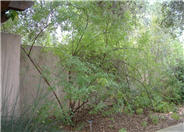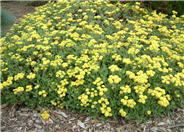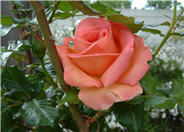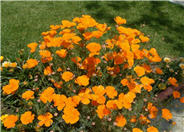
Common name:Cedros Island Verbena
Botanical name:Verbena lilacina 'De La Mina'
Verbena lilacina 'De La Mina' is a selection introduced by the Santa Barbara Botanical Garden. It follows the same wonderful characteristics described under the general species V. lilacina.

Common name:Blue Elderberry
Botanical name:Sambucus mexicana
The blue elderberry is a deciduous shrub that grows 4-10 ft. tall or tree that reaches up to 40 ft. high. The leaves of this plant have 5-9 leaflets with white spring flower clusters developing into blue berries. The blue elderberry is a native to California, is drought tolerant and is a beneficial insect plant.
-Cornflower Farms

Common name:Sulfur Flower
Botanical name:Eriogonum umbellatum
This plant is a low woody perennial growing 1-2 ft. high with 3-4 spread, having dark green foliage and attractive yellow summer flowers. It is a California native that is drought tolerant. It attracts butterflies and beneficial insects. - Cornflower Farms

Common name:Hybrid Tea Rose (selections)
Botanical name:Rosa Hybrid Tea varieties
These shrubs and vines are the most-loved in the West and are very resilient. They come in a wide variety of sizes and colors and are easy to maintain with proper care. They can be used in a water-conserving garden with careful attention to irrigation practices.

Common name:California Poppy, Golden Poppy
Botanical name:Eschscholzia californica
This small annual (sometimes acts as a perennial) plant will grow to less than 1' tall and has light, small blue/green leaves with gold and orange flowers that bloom in spring and summer.

Common name:Deer Grass
Botanical name:Muhlenbergia rigens
The deer grass is a warm season perennial that forms dense clumps from the base. The spike like flower stalks grow 2-3 ft. tall and this grass has striking foundation form. The deer grass is native to California, is drought tolerant, and is a beneficial insect plant. -Cornflower Farms
| Designer: Stephanie Morris | Fence and Flower Explosion |
Photographer: GardenSoft |
Soils and Compost:
Incorporate compost 6" into your soil to retain water, reduce compaction, feed earthworms, and provide valuable nutrients to your plants.
Water Saving Tip:
Check your irrigation systems at least once per month (or after each mowing).
Monitor each cycle to identify obvious problems and to confirm that all of the components are functioning properly.
Contact your water agency for assistance.
Integrated Pest Management:
Attract, or buy beneficial insects such as ladybugs and lacewings to control pest outbreaks in your garden.

